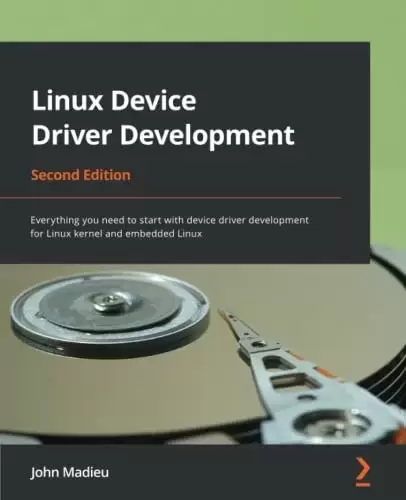
Book Description
Get up to speed with the most important concepts in driver development and focus on common embedded system requirements such as memory management, interrupt management, and locking mechanisms
Key Features
- Write feature-rich and customized Linux device drivers for any character, SPI, and I2C device
- Develop a deep understanding of locking primitives, IRQ management, memory management, DMA, and so on
- Gain practical experience in the embedded side of Linux using GPIO, IIO, and input subsystems
Book Description
Linux is by far the most-used kernel on embedded systems. Thanks to its subsystems, the Linux kernel supports almost all of the application fields in the industrial world. This updated second edition of Linux Device Driver Development is a comprehensive introduction to the Linux kernel world and the different subsystems that it is made of, and will be useful for embedded developers from any discipline.
You’ll learn how to configure, tailor, and build the Linux kernel. Filled with real-world examples, the book covers each of the most-used subsystems in the embedded domains such as GPIO, direct memory access, interrupt management, and I2C/SPI device drivers. This book will show you how Linux abstracts each device from a hardware point of view and how a device is bound to its driver(s). You’ll also see how interrupts are propagated in the system as the book covers the interrupt processing mechanisms in-depth and describes every kernel structure and API involved. This new edition also addresses how not to write device drivers using user space libraries for GPIO clients, I2C, and SPI drivers.
By the end of this Linux book, you’ll be able to write device drivers for most of the embedded devices out there.
What you will learn
- Download, configure, build, and tailor the Linux kernel
- Describe the hardware using a device tree
- Write feature-rich platform drivers and leverage I2C and SPI buses
- Get the most out of the new concurrency managed workqueue infrastructure
- Understand the Linux kernel timekeeping mechanism and use time-related APIs
- Use the regmap framework to factor the code and make it generic
- Offload CPU for memory copies using DMA
- Interact with the real world using GPIO, IIO, and input subsystems
Who this book is for
This Linux OS book is for embedded system and embedded Linux enthusiasts/developers who want to get started with Linux kernel development and leverage its subsystems. Electronic hackers and hobbyists interested in Linux kernel development as well as anyone looking to interact with the platform using GPIO, IIO, and input subsystems will also find this book useful.
中文:
书名:Linux设备驱动程序开发:开始为Linux内核和嵌入式Linux开发设备驱动程序所需的一切,第2版
熟悉驱动程序开发中最重要的概念,并关注常见的嵌入式系统需求,如内存管理、中断管理和锁定机制
主要特点
- 为任何字符、SPI和I2C设备编写功能丰富的定制Linux设备驱动程序
- 深入了解锁定原语、IRQ管理、内存管理、DMA等
- 获得使用GPIO、IIO和输入子系统的Linux嵌入式方面的实践经验
图书描述
到目前为止,Linux是嵌入式系统上使用最多的内核。多亏了它的子系统,Linux内核支持工业世界中几乎所有的应用领域。这本更新的Linux设备驱动程序开发第二版全面介绍了Linux内核世界和组成它的不同子系统,对于任何学科的嵌入式开发人员都很有用。
您将学习如何配置、定制和构建Linux内核。这本书充满了真实世界的例子,涵盖了嵌入式领域中每一个最常用的子系统,如GPIO、直接内存访问、中断管理和I2C/SPI设备驱动程序。本书将向您展示Linux如何从硬件的角度抽象每个设备,以及如何将设备绑定到其驱动程序。您还将看到中断是如何在系统中传播的,因为本书深入介绍了中断处理机制,并描述了涉及的每个内核结构和API。这个新版本还解决了如何不使用用户空间库为GPIO客户端、I2C和SPI驱动程序编写设备驱动程序。
到本书结束时,您将能够为市面上大多数嵌入式设备编写设备驱动程序。
What you will learn
- 下载、配置、构建和定制Linux内核
- 使用设备树描述硬件
- 编写功能丰富的平台驱动程序并利用I2C和SPI总线
- Get the most out of the new concurrency managed workqueue infrastructure
- 了解Linux内核计时机制并使用与时间相关的API
- 使用regmap框架对代码进行分解并使其成为泛型
- Offload CPU for memory copies using DMA
- 使用GPIO、IIO和输入子系统与现实世界交互
Who this book is for
这本Linux OS书籍是为想要开始使用Linux内核开发并利用其子系统的嵌入式系统和嵌入式Linux爱好者/开发人员编写的。对Linux内核开发感兴趣的电子黑客和爱好者以及任何希望使用GPIO、IIO和输入子系统与该平台交互的人也会发现这本书很有用。
评论前必须登录!
注册